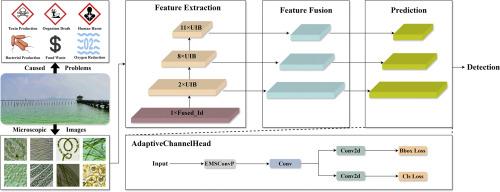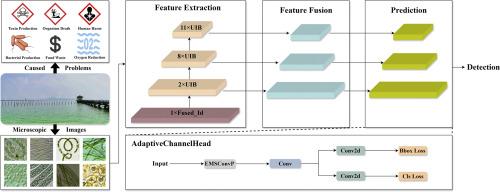MobileYOLO-Cyano: An enhanced deep learning approach for precise classification of cyanobacterial genera in water quality monitoring
IF 12.4
1区 环境科学与生态学
Q1 ENGINEERING, ENVIRONMENTAL
引用次数: 0
Abstract
Cyanobacteria pose a critical challenge for freshwater management due to their ability to rapidly proliferate and produce toxins that can jeopardize human health, even at low concentrations. Therefore, effective methods to accurately classify cyanobacterial genera are essential for water quality assessment. However, existing automated classification methods often suffer from low accuracy or limitations in identifying cyanobacterial genera. To address these challenges, we propose a novel deep learning model, MobileYOLO![]() Cyano, which integrates YOLOv8 with MobileNetV4, optimizes the anchor-free detection framework, and introduces a newly designed AdaptiveChannelHead module to enhance feature extraction and genus-level classification. The MobileYOLO
Cyano, which integrates YOLOv8 with MobileNetV4, optimizes the anchor-free detection framework, and introduces a newly designed AdaptiveChannelHead module to enhance feature extraction and genus-level classification. The MobileYOLO![]() Cyano model was evaluated on a dataset comprising nine cyanobacterial genera, which have been reported to possess the potential to produce multiple types of cyanotoxins, and achieved impressive results: 97.09 % precision, 96.82 % recall, 96.95 % F1 score, and 98.17 % mAP50. Notably, the model demonstrated significant improvements compared to previous studies in accurately classifying challenging genera (Aphanizomenon, Phormidium, Planktothrix, and Raphidiopsis), with precision and recall increasing by over 10 %. Furthermore, the model’s consistently high F1 scores across a wide range of confidence thresholds demonstrates its robustness and flexibility. These results highlight the advancements made by our proposed approach and demonstrate its capability to serve as a valuable tool for water quality management and sustainable development.
Cyano model was evaluated on a dataset comprising nine cyanobacterial genera, which have been reported to possess the potential to produce multiple types of cyanotoxins, and achieved impressive results: 97.09 % precision, 96.82 % recall, 96.95 % F1 score, and 98.17 % mAP50. Notably, the model demonstrated significant improvements compared to previous studies in accurately classifying challenging genera (Aphanizomenon, Phormidium, Planktothrix, and Raphidiopsis), with precision and recall increasing by over 10 %. Furthermore, the model’s consistently high F1 scores across a wide range of confidence thresholds demonstrates its robustness and flexibility. These results highlight the advancements made by our proposed approach and demonstrate its capability to serve as a valuable tool for water quality management and sustainable development.


MobileYOLO-Cyano:水质监测中蓝藻属精确分类的增强深度学习方法
蓝藻对淡水管理构成重大挑战,因为它们能够迅速增殖并产生毒素,即使浓度很低也可能危害人类健康。因此,准确分类蓝藻属的有效方法对水质评价至关重要。然而,现有的自动分类方法往往遭受准确性低或限制在识别蓝藻属。为了解决这些挑战,我们提出了一种新的深度学习模型MobileYOLO-Cyano,该模型集成了YOLOv8和MobileNetV4,优化了无锚检测框架,并引入了新设计的AdaptiveChannelHead模块来增强特征提取和类级分类。MobileYOLO-Cyano模型在包含9个蓝藻属的数据集上进行了评估,这些蓝藻属具有产生多种蓝藻毒素的潜力,并取得了令人印象深刻的结果:97.09%的准确率,96.82%的召回率,96.95%的F1得分和98.17%的mAP50。值得注意的是,与以往的研究相比,该模型在准确分类具有挑战性的属(aphanizomena、Phormidium、plankton thrix和Raphidiopsis)方面有了显著的改进,准确率和召回率提高了10%以上。此外,该模型在广泛的置信阈值范围内始终如一的高F1分数表明其稳健性和灵活性。这些结果突出了我们提出的方法所取得的进步,并证明了它作为水质管理和可持续发展的宝贵工具的能力。
本文章由计算机程序翻译,如有差异,请以英文原文为准。
求助全文
约1分钟内获得全文
求助全文
来源期刊

Water Research
环境科学-工程:环境
CiteScore
20.80
自引率
9.40%
发文量
1307
审稿时长
38 days
期刊介绍:
Water Research, along with its open access companion journal Water Research X, serves as a platform for publishing original research papers covering various aspects of the science and technology related to the anthropogenic water cycle, water quality, and its management worldwide. The audience targeted by the journal comprises biologists, chemical engineers, chemists, civil engineers, environmental engineers, limnologists, and microbiologists. The scope of the journal include:
•Treatment processes for water and wastewaters (municipal, agricultural, industrial, and on-site treatment), including resource recovery and residuals management;
•Urban hydrology including sewer systems, stormwater management, and green infrastructure;
•Drinking water treatment and distribution;
•Potable and non-potable water reuse;
•Sanitation, public health, and risk assessment;
•Anaerobic digestion, solid and hazardous waste management, including source characterization and the effects and control of leachates and gaseous emissions;
•Contaminants (chemical, microbial, anthropogenic particles such as nanoparticles or microplastics) and related water quality sensing, monitoring, fate, and assessment;
•Anthropogenic impacts on inland, tidal, coastal and urban waters, focusing on surface and ground waters, and point and non-point sources of pollution;
•Environmental restoration, linked to surface water, groundwater and groundwater remediation;
•Analysis of the interfaces between sediments and water, and between water and atmosphere, focusing specifically on anthropogenic impacts;
•Mathematical modelling, systems analysis, machine learning, and beneficial use of big data related to the anthropogenic water cycle;
•Socio-economic, policy, and regulations studies.
 求助内容:
求助内容: 应助结果提醒方式:
应助结果提醒方式:


